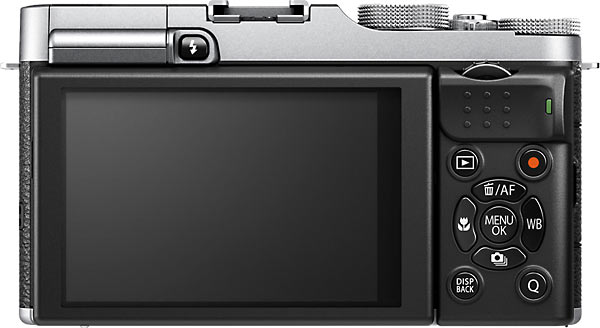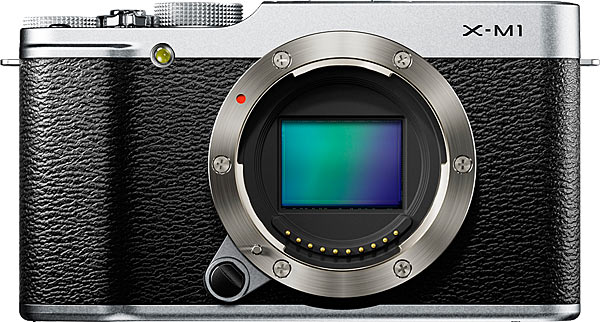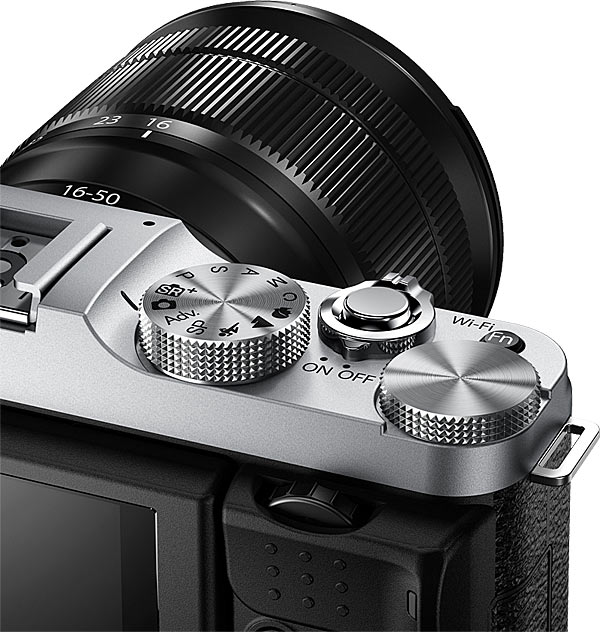Review Date: September 3, 2013
Category: Beginner to Serious Amateur


Photoxels Gold Award – Beginner Interchangeable Lens Camera
HANDLING & FEEL
Compact mirrorless Interchangeable Lens Camera. Fujifilm is positioning the X-M1 as the next generation entry-level mirrorless DSLR you would want to upgrade to from your point-and-shoot digicam. Not only does the X-M1 match entry-level DSLRs in features, performance and image quality, but it does so in a fraction of the size and weight. It does no harm that the X-M1 is also exquisitely beautiful, whether in its all-black, black/silver or brown version, with an elegant and classic retro design reminiscent of 35mm rangefinder cameras.
The X-M1 also targets those who may have already bought an entry-level DSLR but is unhappy with the bulk, weight and complicated controls. Compare the the X-M1 with the Canon EOS Rebel T5i:
[All comparison images courtesy of camerasize.com.]The size difference is obvious, but where it really strikes home is when you compare their thicknesses:
The difference in thickness is due to the Fujifilm engineers removing the redundant mirror, allowing for a much slimmer camera.
Now, Canon has built the EOS SL1 DSLR that is as wide and high as the X-M1. Again, it’s all good until you view their respective thicknesses:
[Interestingly, Canon can build mirrorless DSLRs, as is attested by their diminutive EOS M — their compact mirrorless that is even smaller than the X-M1. Unfortunately, half-hearted marketing and sales efforts have prevented it from gaining much traction.]The front of the camera has a clean design with the AF-assist Illuminator/Self-Timer lamp and the Lens Release Button, both on the left of the mount. It has the X Mount and therefore accepts all the Fujifilm XF and XC lenses, as well as compatible Leica, Voigtlander, and Zeiss lenses using the M Mount Adapter.
The X-M1 has just a hint of a handgrip and I find that, with the XC16-50mm lens attached, it is more comfortable carrying it by the lens.
TIP: For those with bigger hands, there is an optional and larger Hand Grip HG-XM1 (B&H, Adorama, Amazon.com
) that attaches to the bottom of the camera.

The top of the camera is also refreshingly clean. Viewing from the back, there’s the Shutter Release button with the Power ON/OFF Switch around it. To the right of the Shutter button, there are the Fn button and the Main Command Dial. To the left, there are the Mode Dial, the hot shoe and the pop-up flash. Set to Commander mode, the pop-up flash can trigger (though apparently not control) optional remote flash units. When an external flash is mounted on the hot shoe, you most probably will not be able to pop up the built-in flash.
All the control dials and buttons look and feel top notch. The Power Switch seems just a bit on the stiff side for my taste. On the positive side, you won’t inadvertently turn the camera On or OFF as I have experienced on other cameras.
The Fn button defaults to Wi-Fi (in Playback). You can change its functionality in the Menu [SHOOTING MENU 3 – FUNCTION (Fn) SETTING]. You can set Fn to one of the following: Preview Depth of Field, ISO, Self-timer, Image Size, Image Quality, Dynamic Range, Film Simulation, Photometry, AE/AF Lock, Instant AF, Focus Mode, Face Detector, Location Info Search, Movie Mode, RAW.
TIP: Instead of going through the Menu, just press and hold the Fn button for about 2 seconds to immediately enter the Customize Fn Button screen.
To use Manual Focus, you need to go into the Menu – Shooting Menu 4 – Manual or select it in the Q. Menu. It is much easier with Focus Peaking set [Menu – Shooting Menu 4 – MF Assist – Focus Peak Highlight – select Low or High].
In PAS modes, the Main Command ("top") Dial affects exposure compensation and the Sub-command ("Rear") Dial affects Program Shift, Aperture and Shutter Speed, respectively. In M mode, the Command Dial affects the Shutter Speed and the Sub-command Dial affects the Aperture.
TIP: In Program mode, Program Shift is available only if AUTO ISO and AUTO DR are not selected.
Many of these function can also be displayed on the Control Info screen. Press the recessed Q (Quick Menu) button on the back to display the Control Info screen, select using the Selector and set using the Main Command dial or Sub-command dial.
The Main Command Dial rotates quite easily and you can inadvertently dial in an exposure compensation, so it’s always a good idea to get into the habit of checking it.

On the back we have a 3.0-in. LCD with 920k-dot resolution. The LCD is tiltable 90° up and 85° down. It is not touchscreen, which is a plus or minus, depending on whether you like touchscreen or not. Anyway, the controls are well implemented and choosing an AF point using the Selector is easy and quick.
There is no built-in viewfinder on the X-M1, nor is an external one available. Keep in mind that the users this camera is targeting are used to composing on the LCD so the lack of a viewfinder should not pose an issue to them.
On the right side of the LCD are the Sub-command Dial, Playback button, Movie button, Multi Selector, DISP/BACK button and the recessed Q button.
TIP: Press and hold the DISP/BACK button for about 3 seconds to immediately switch to SILENT MODE: all operational sounds are turned off and the AF Assist light and flash are disabled. Unfortunately, the shutter, being mechanical, will always make a noise. Note that SILENT MODE stays ON even when you turn off the camera. So, don’t forget to reset it in the menu.
Above the LCD is the Flash pop-up button. The flash moves freely up and down so theoretically you could use it as a bouce flash (though it does not stay pointed up so you will have to use a finger to hold it in position).
The tripod mount at the bottom of the camera is not inline with the center of the lens and you won’t be able to change batteries/SD card with the camera mounted on a tripod.
Included in the box is a rechargeable Li-ion battery NP-W126 that can take about 350 shots on a fresh charge. A battery charger BC-W126 recharges a depleted battery in approx. 150 min.
The Fujifilm X-M1 uses the SD / SDHC / SDXC memory card.
Even though the Fujifilm X-M1 is mostly polycarbonate plastic, it is incredibly solid and well-built, with a feel of quality all around. The handgrip is on the small side and so the advertised one-handed operation is a bit of a stretch (though the optional handgrip may help here); you will need both hands to operate this camera comfortably. That said, the control dials, both in their placement and operation, are well thought out and implemented and make the X-M1 an intuitive and very enjoyable camera to use.
Next: Fujifilm X-M1 User’s Experience
Related Links:
























